André Lanskoy1902 - 1976Untitled signedoil on canvas195 x 96,5 cm ; 76¾x 38 in. This work is accompanied by a letter of inclusion in the forthcoming André Lanskoy Catalogue Raisonné.__________________________________________________________________________ André Lanskoy1902 - 1976Untitled signéhuile sur toile195 x 96,5 cm ; 76¾x 38 in. Cette œuvre est accompagnée d'un avis d'inclusion au Catalogue Raisonné d'André Lanskoy actuellement en préparation.Condition reportFor further information on the condition of this lot please contact Armance.Gay@sothebys.com ProvenanceGalerie Kriegel, Paris Enchères MSA, Pontoise, Tableaux, sculptures & design, Art Moderne & Contemporain : Hommage à André Kriegel et divers amateurs, 4 December 2004, lot 96 Private Collection, Neuchâtel Sotheby's, Paris, Art Contemporain, 31 May 2011, lot 24 Acquired from the above by the present ownerCatalogue note"I like Lanskoy and de Staël the most, they who are the most abstract, who do not follow Matisse, Bonnard, or even Picasso." (Jeanne Bucher, Letter to Maria Helena Vieira da Silva and Arpad Szenes, May 28, 1945). André Lanskoy a Russian painter born into an aristocratic family, received his first education in the Corps des Pages de Sa Majesté Royale in Saint Petersburg. An unruly student because of his dislike of military discipline, Lanskoy spent most of his time frequenting avant-garde literary cafés before moving to Paris in 1921 at the age of nineteen. Deeply influenced by traditional folk art, particularly the work of Soudieïkine whose Parisian studio he visited upon his arrival in the capital, as well as by the expressionist movement in France, his first works in a figurative style reveal an interest in van Gogh, Matisse and Soutine. Thereafter, his technique gradually evolved before finally adopted a ‘tachist’ approach from 1939 which would become characteristic of his work. Indeed, Lanskoy is considered one of the pioneering artists of Tachisme - like his friend Nicolas de Staël - a movement that flourished in France in the 1940s and 1950s, in response to Cubism, and one which is characterized by bold brushstrokes combined with a vibrant colour palette. "His taste for colour is evident early on. He loved red balloons, he collected streetcar tickets in a great diversity of shades, which he accumulated according to their colour. He spends long hours contemplating the charmankas (barrel organs), with their long floating ribbons, of all colours, and the petrouchkas (puppets) with their brightly coloured decorations. He also liked the circus, which was very popular in Moscow at that time; he liked its brilliance, its colorfulness, its modernity.” (Quoted by Pascaline Dron, Angelo Pittiglio, Lanskoy, Paris, 1990, pp.15-16) Composition, takes place in the period of abstract non-figuration which Lanskoy initiated in the late 1940s. The brushstrokes, characterised by vivid colors, stand out against a background of intense black. The work has a large format and is marked by a great dynamism on its entire surface, an energetic tension arising from the interaction between the different colours used by the artist. __________________________________________________________________________ « J’aime le plus Lanskoy et de Staël qui sont les plus abstraits, qui ne suivent ni Matisse, ni Bonnard, ni même Picasso. » (Jeanne Bucher, Lettre à Maria Helena Vieira da Silva et Arpad Szenes, 28 mai 1945). André Lanskoy peintre russe né dans une famille aristocratique, reçoit sa première éducation dans le Corps des Pages de Sa Majesté Royale à Saint-Pétersbourg. Elève peu assidu en raison de son désamour de la discipline militaire, Lanskoy consacre la majeure partie de son temps à fréquenter les cafés littéraires d’avant-garde avant de s’installer à Paris en 1921 à l’âge de dix-neuf ans. Profondément influencé par l’art populaire traditionnel, notamment par l’œuvre de Soudieïkine dont il fréquente l’atelier parisien à son arrivée dans la capitale, ainsi que par le mouv
André Lanskoy1902 - 1976Untitled signedoil on canvas195 x 96,5 cm ; 76¾x 38 in. This work is accompanied by a letter of inclusion in the forthcoming André Lanskoy Catalogue Raisonné.__________________________________________________________________________ André Lanskoy1902 - 1976Untitled signéhuile sur toile195 x 96,5 cm ; 76¾x 38 in. Cette œuvre est accompagnée d'un avis d'inclusion au Catalogue Raisonné d'André Lanskoy actuellement en préparation.Condition reportFor further information on the condition of this lot please contact Armance.Gay@sothebys.com ProvenanceGalerie Kriegel, Paris Enchères MSA, Pontoise, Tableaux, sculptures & design, Art Moderne & Contemporain : Hommage à André Kriegel et divers amateurs, 4 December 2004, lot 96 Private Collection, Neuchâtel Sotheby's, Paris, Art Contemporain, 31 May 2011, lot 24 Acquired from the above by the present ownerCatalogue note"I like Lanskoy and de Staël the most, they who are the most abstract, who do not follow Matisse, Bonnard, or even Picasso." (Jeanne Bucher, Letter to Maria Helena Vieira da Silva and Arpad Szenes, May 28, 1945). André Lanskoy a Russian painter born into an aristocratic family, received his first education in the Corps des Pages de Sa Majesté Royale in Saint Petersburg. An unruly student because of his dislike of military discipline, Lanskoy spent most of his time frequenting avant-garde literary cafés before moving to Paris in 1921 at the age of nineteen. Deeply influenced by traditional folk art, particularly the work of Soudieïkine whose Parisian studio he visited upon his arrival in the capital, as well as by the expressionist movement in France, his first works in a figurative style reveal an interest in van Gogh, Matisse and Soutine. Thereafter, his technique gradually evolved before finally adopted a ‘tachist’ approach from 1939 which would become characteristic of his work. Indeed, Lanskoy is considered one of the pioneering artists of Tachisme - like his friend Nicolas de Staël - a movement that flourished in France in the 1940s and 1950s, in response to Cubism, and one which is characterized by bold brushstrokes combined with a vibrant colour palette. "His taste for colour is evident early on. He loved red balloons, he collected streetcar tickets in a great diversity of shades, which he accumulated according to their colour. He spends long hours contemplating the charmankas (barrel organs), with their long floating ribbons, of all colours, and the petrouchkas (puppets) with their brightly coloured decorations. He also liked the circus, which was very popular in Moscow at that time; he liked its brilliance, its colorfulness, its modernity.” (Quoted by Pascaline Dron, Angelo Pittiglio, Lanskoy, Paris, 1990, pp.15-16) Composition, takes place in the period of abstract non-figuration which Lanskoy initiated in the late 1940s. The brushstrokes, characterised by vivid colors, stand out against a background of intense black. The work has a large format and is marked by a great dynamism on its entire surface, an energetic tension arising from the interaction between the different colours used by the artist. __________________________________________________________________________ « J’aime le plus Lanskoy et de Staël qui sont les plus abstraits, qui ne suivent ni Matisse, ni Bonnard, ni même Picasso. » (Jeanne Bucher, Lettre à Maria Helena Vieira da Silva et Arpad Szenes, 28 mai 1945). André Lanskoy peintre russe né dans une famille aristocratique, reçoit sa première éducation dans le Corps des Pages de Sa Majesté Royale à Saint-Pétersbourg. Elève peu assidu en raison de son désamour de la discipline militaire, Lanskoy consacre la majeure partie de son temps à fréquenter les cafés littéraires d’avant-garde avant de s’installer à Paris en 1921 à l’âge de dix-neuf ans. Profondément influencé par l’art populaire traditionnel, notamment par l’œuvre de Soudieïkine dont il fréquente l’atelier parisien à son arrivée dans la capitale, ainsi que par le mouv

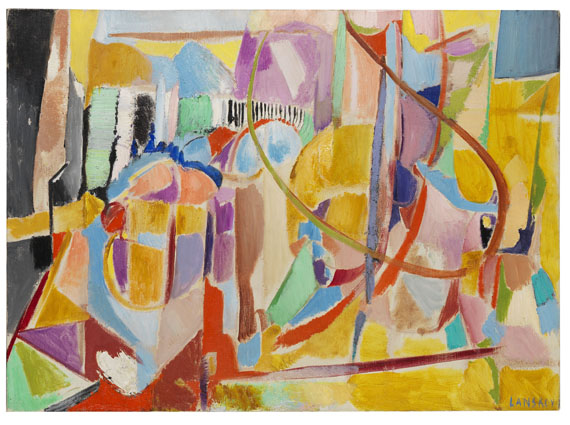
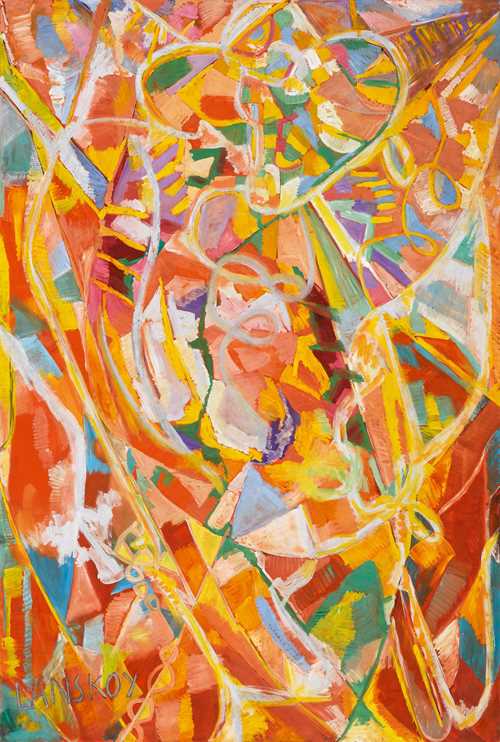
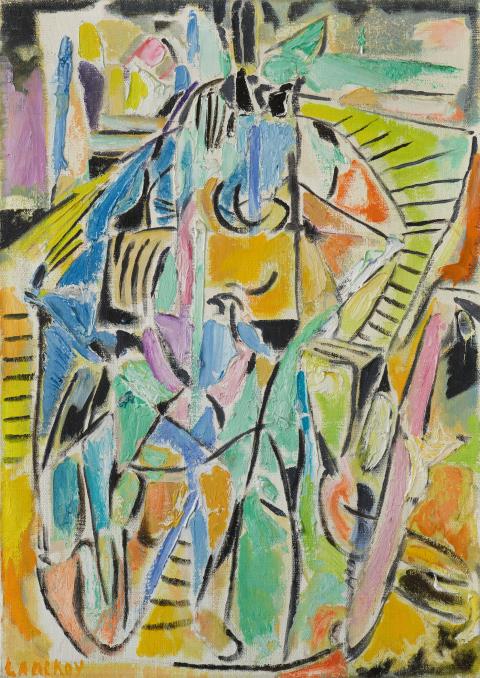
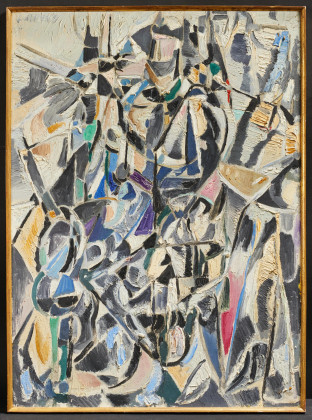




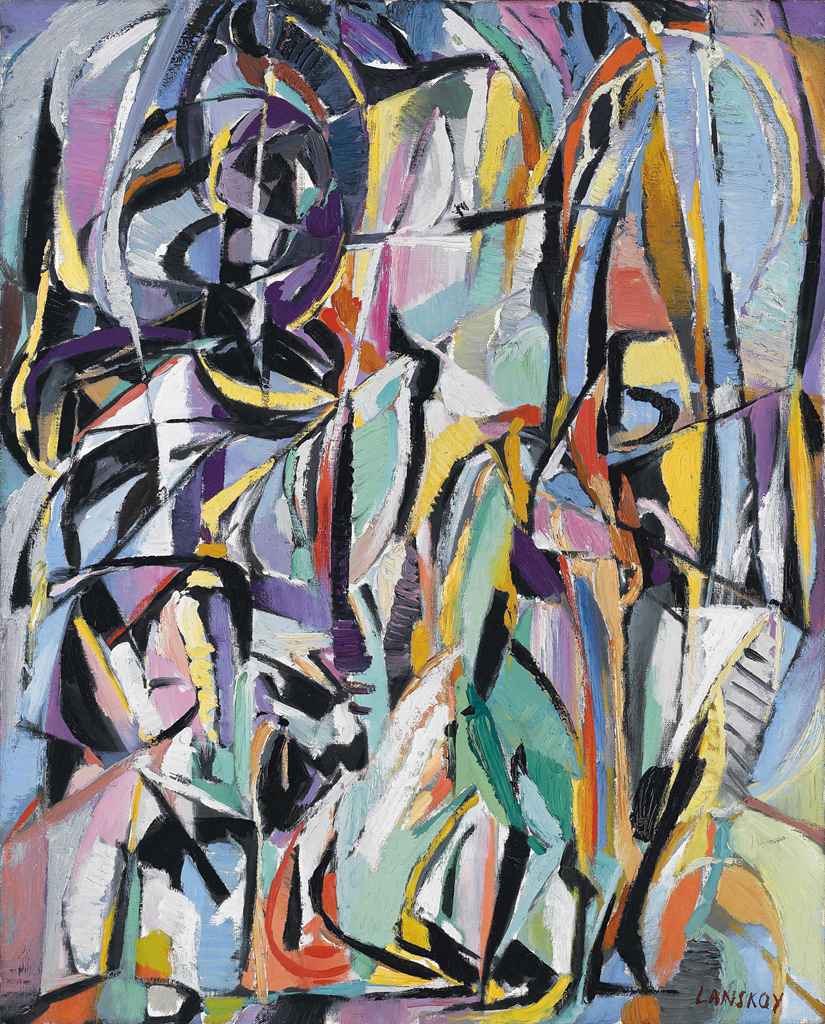

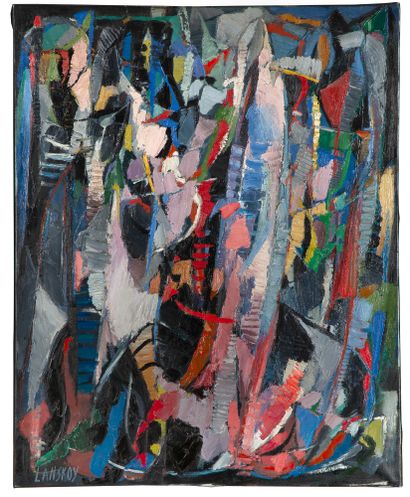


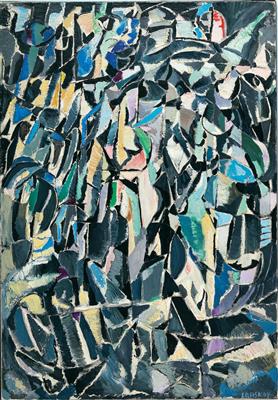
Try LotSearch and its premium features for 7 days - without any costs!
Be notified automatically about new items in upcoming auctions.
Create an alert